#stegocephalian
Text
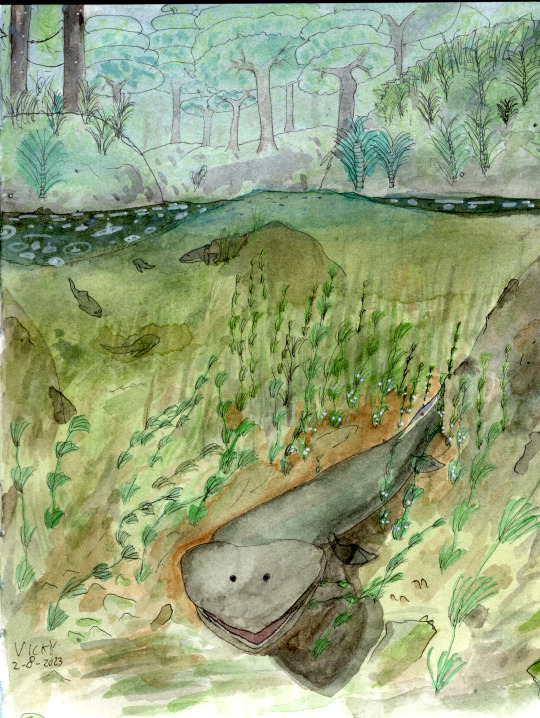
On a rainy Devonian day, a Tiktaalik father guards his eggs in a small forest river. Meanwhile, his hunting mate has her eye on a Bothriolepis. Another Bothriolepis is eating something buried in the river sediment, drawing the attention of a Coccosteus.
I've wanted to draw Tiktaalik for a while. It's easily the most depicted creature of the Devonian, but it always seems to get shown boldly pulling itself onto the land. While that was of course extremely important in hindsight, surely they spent much more of their time living quite happily underwater. So here's some interesting behaviour some lungfish do: the dads guard their eggs after they're lain in water plants.
#tiktaalik#stegocephalian#lobe-finned fish#devonian#bothriolepis#coccosteus#placoderm#archaeopteris#chara#rhacophyton#paleoart#my art#rain#forest#rainy#palaeoblr
81 notes
·
View notes
Text
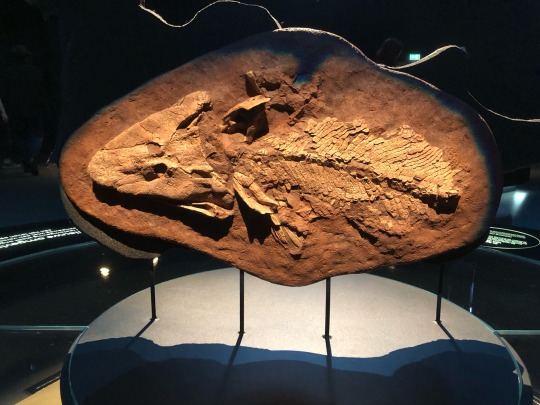
Tiktaalik!
119 notes
·
View notes
Text
Day 25

#acherontiscus#stegocephalians#Carboniferous#early Carboniferous#drawing a prehistoric animal everyday
1 note
·
View note
Text
ribbit ribbit let's destroy linneaus some more
thanks to @quark-nova for the excellent clade options
205 notes
·
View notes
Text
A Prologue to Amniotes
Part III - The “Age of Amphibians”
A long time has passed since my previous blog post. Two months, or around twenty million years, depending on how you count.
We are now in the middle of the Carboniferous (late Mississippian for the Americans out there). Stegocephalians are out of fashion, new models of amphibians have been released. They’re actually able to spend most of their time on land! (well, a few went back to the water, but still)
Unfortunately, there’s no real word for this faunal shift. An interesting concept that we can use, however, is the one of megadynasty. They’re basically evolutionary faunas but on land, an idea introduced by Brenchley and Harper in 1998. Basically, Megadynasty I corresponds to the amphibians and pelycosaurians, Megadynasty II is the therapsids, and Megadynasty III is the dinosaurs. You can quickly see how this is more than approximative, as I doubt Ichthyostega and Dimetrodon have much in common to justify this grouping. Oh, and they forgot the entire Cenozoic.
A better system would be to have a “Megadynasty 0″ corresponding to the stegocephalians (when the “going on land” functionality was still in beta), with I for the later amphibians and II for the pelycosaurians. Here’s a schema:

Seven-megadynasty paradigm, by Quark-Nova (CC-SA 3.0)
Are the amphibians really the only ones to dominate the ecosystem? Certainly not - giant insects and arthropods would certainly like to have a word with them. And, quite honestly, a two-meter long Arthropleura or a 350 kilogram Hibbertopterus would probably win an argument against me on intimidation alone. But, unfortunately for them, I’m still alive and they aren’t - fact is, amphibians and their descendants ultimately did a better job at shaping the megafauna. Which is why the goal of this blog is to talk about synapsid evolution, rather than giant insect evolution.
But what was the Carboniferous like exactly? Popular conception pictures it as a mostly uniform “rainforest” of giant fern trees. And, while it’s not completely wrong, something is quite often left out of the picture. The Middle Carboniferous saw the beginning of the Karoo ice age, an icehouse world that would last until the Permian and see large ice sheets cover much of the planet. But the ice age wasn’t at its peak yet, and amphibians could comfortably chill in the rainforest. For now, at least.
So, what were they doing? Quite a lot, actually. A lot of them decided that becoming l o n g was the way to go, with adelospondyls, aistopods and various other groups ranging in body plans from reptilian ferret to actual snake.

Rhynchonkos, a ferret microsaur, by Smokeybjb (CC-SA 3.0)
A lot of these groups were historically classified as “lepospondyls”, with everyone’s favourite boomerang-headed Diplocaulus, although early tetrapod classification is conspicuously inconsistent - Rhynchonkos up there might actually be an early reptile! Lepospondyls themselves might be more related to amniotes, to modern amphibians, or away from the branch leading to both entirely.
Another group that dominated the middle Carboniferous, temnospondyls, are more well-grounded - both phylogenetically and in terms of their terrestrial lifestyle. The likely ancestors of modern frogs and salamanders, a lot of them were ironically way less reliant on water, with scales allowing them to retain humidity more efficiently (modern amphibians are smooth). They also had way more game impact than their descendants, with even early forms like Capetus reaching a meter and a half, and being more crocodile-like in appearance.

Capetus, an early temnospondyl, by Dmitry Bogdanov (CC-SA 3.0)
Unfortunately, a design flaw still remained, as their eggs and babies still needed water to develop in. Although some temnospondyls had an innovative solution: laying their eggs in humid crevices, allowing them to reproduce even far away from actual bodies of water!
Another group was on the rise, concurrently with temnospondyls. Reptiliomorphs are often discussed as major players in the middle Carboniferous fauna, although this word hides a lot of complexity under the hood. In fact, any creature closer to amniotes than to modern amphibians is classified as a “reptiliomorph” - even possibly lepospondyls. Really, the trend of gradual independence from water wasn’t a linear path, but several groups trying out innovations concurrently. Internal fertilization, direct development (skipping the problematic tadpole stage), and ultimately, one that would revolutionize life on land: the amniotic egg.
#a prologue to amniotes#carboniferous#palaeoblr#mississippian#pennsylvanian#serpukhovian#lepospondyli#temnospondyli#reptiliomorpha
18 notes
·
View notes
Text
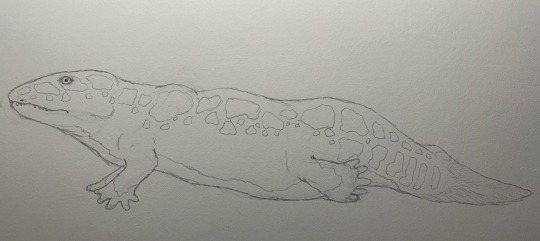
Ichthyostega stensioei was a stegocephalian tetrapodomorph from the Late Devonian of Greenland. Despite some characterizations of it as a true tetrapod akin to a giant salamander, its limbs and joints were very primitive, with only its forelimbs adapted to some terrestrial weight-bearing. This would’ve allowed it to haul itself up onto the shores of its wetland environment, an adaptation that would be further tweaked and improved upon as tetrapods made more prolonged and even permanent moves onto land.
29 notes
·
View notes
Photo
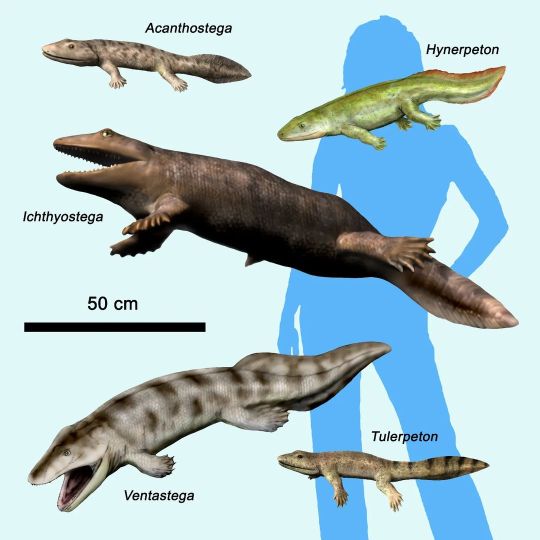
After the "fishapods", here are the earliest stegocephalians, the stem tetrapods... https://www.instagram.com/p/Chin_v4vlGY/?igshid=NGJjMDIxMWI=
0 notes
Photo

An alpha predator of the ocean pursuing a stegocephalian-tetrapod (^u^)
3 notes
·
View notes
Note
Temnospondyl, lepospondyl or polyphyletic origin of lissamphibians?
Given that this is still an open question among specialists, my input on this topic wouldn’t count for much. What I can say is that current literature appears to generally favor a temnospondyl origin for modern amphibians, but supporters of a lepospondyl origin still exist (and have some important publications in the works). Probably no one working on early stegocephalians supports the polyphyly hypothesis (in the sense that some modern amphibians are temnospondyls and others are lepospondyls) anymore, though a recent study found a novel topology in which caecilians are only distantly related to batrachians (salamanders and frogs) despite both being temnospondyls.
6 notes
·
View notes
Note
If you're taking suggestions - for amphibians I'm thinking of elpistostegalians (fishapods), stegocephalians (limbed tetrapods), crown-tetrapods, temnospondyls, lissamphibians and batrachians as possible options? (Now I'm too invested I need to make fun polls too x)
yess perfect, I will include all of them
12 notes
·
View notes
Text
A Prologue to Amniotes
Part II - Bridging the gap
We left our early tetrapods in the wake of one of the most disastrous mass extinctions ever. Unfortunately, they all died.
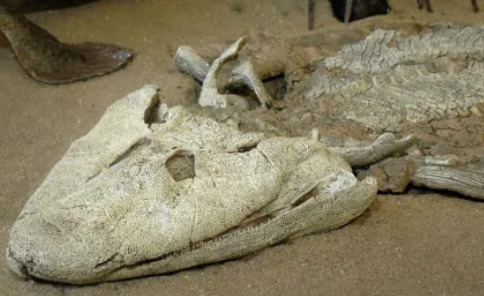
Tiktaalik, not in its greatest shape today (University of Chicago/Beth Rooney/Associated Press)
Well, not all of them. But that’s definitely what the fossil record would have you believe. We have entered the Carboniferous period (Mississippian for the Americans out here), and, with it, the enigmatic Romer’s gap.
This gap didn’t only affect early tetrapods. In the wake of the late-Devonian extinction, we find a 20 million year long stretch of Carboniferous with extremely few fossils, leaving a gap in our understanding of the crucial Devonian-Carboniferous transition - and of early tetrapod evolution.

West Lothian, Scotland, source of many early Carboniferous fossils and British parliamentary questions (Anne Burgess, CC-BY-SA 2.0)
Could this gap simply be an artifact? It is definitely possible that the conditions in the early Carboniferous weren’t especially conductive to fossilization, and a few fossils have in fact been found from the gap itself!
However, it appears that this gap corresponded to a genuine point of low diversity. Oxygen levels were critically low at the time (by Carboniferous standards, so a little under modern-day level), causing a decline in diversity in both tetrapods and terrestrial arthropods. Which would have quite an interesting consequence for their conquest of land, with both evolving in relative obscurity ahead of a future radiation.

Crassigyrinus, an early aquatic tetrapod from the Romer Gap of Scotland (Nobu Tamura, CC BY-SA 3.0)
As we saw last time, the first “stegocephalian”-grade tetrapods weren’t really terrestrial at all. And, while a few of them would be found in the waters of Romer’s gap itself (like the fully aquatic Crassigyrinus, pictured above), they would leave the next generation of tetrapods to make its debuts on land, with strong, forward-facing limbs fully adapted to life on land.

Life reconstruction of the early tetrapod Pederpes showing the forelimb bones beneath the skin (Julia Molnar, Copyright 2021)
The best embodiment of this transition is undoubtably Pederpes. Another of the rare Romer’s gap finds, this “amphibian” still had the characteristic many-fingered limbs of their stegocephalian ancestors, while already showing signs of the transition towards pentadactyly - the sixth digit wasn’t weight-bearing at all. Interestingly, its post-Romer relatives like Whatcheeria would be fully pentadactylous - converging with the condition found in modern tetrapods.
These forerunners would coexist with more derived tetrapods, whose soon to be dominant lineages made their obscure debuts during the gap. It is during this time that the ancestors of modern-day amphibians and amniotes - respectively, temnospondyls like Balanerpeton and reptiliomorphs like Eldeceeon - would diverge, and become mostly or fully terrestrial. Along with a third enigmatic group, the lepospondyls, they would come to define the ecosystems of the middle Carboniferous...
8 notes
·
View notes
Note
Does the microsaur + lysorophian clade have a name?
Not that I know of. But it should be said that most of my answers to questions about early stegocephalian systematics will likely be “I don’t know”, “it’s a goddamn mess”, or both.
2 notes
·
View notes
Photo

Jurassic Emblem-Chapter 16
“Oh yeah! Let’s see how long that Ylissean spunk-bucket will las-AAGGGRH!! YA BASTID--!!” - Dmortri, 3 milliseconds before Chrom snapped his neck.
“Wind or rain, life or death, I will fight my lady Yuwi’s enemies until the end-oh. Shit.”- Edelgore, her first and last line when Chrom sliced her with his move Emmeryn’s Evisceration.
~~~~~~~~~
“Chrom-san of ex-Ylisse. What are you doing? While condemning our troops in a blood gore-nado is a very effective method for acquiring experience points, it will make the war more difficult for each soldier that falls into hell.” Teba said, mounted on top of Amirg, poised for battle.
“What right do you have to talk to me, Whore-shidan,” Chrom growled, his psychological limiter gone down the drain hours ago. “even if Lucina is dead, I’m going to sell your eyeballs and hearts to Anna!”
“Ysae, ysae, won yeh,” Amirg the Indominpteryx teased the fuming blue-haired man. “won rof...evila si lirg ybab dellik-ton ruoy.”
“Dda thigm I fi, ssenisub evitarcul eht etuiq si noitatiolpxe dlihc hguoht,” the backwards-speaking dragon chuckled.
“Shut up, you heinous hybrids! Hand over Lucina if you want to see another day ever again!” Blue demanded, perched on top of Rexy’s ginormous head.
When Basilice had flown over to the raptors in ex-Ylisse that Amirg had rescued Warbler and Teba earlier, they can only imagine the immense rage Chrom felt when they told him the unfortunate news that occurred after the boss fight with Sobek and Gorgonorhea.
Almost any parent is willing to murder others if it meant protecting their progeny, Blue thought, but the way Chrom displayed his resentment for the forces that kidnapped his daughter....it was simply terrifying. It was as though no sentient organism mattered to the man other than his daughter, and when Sharena attempted to calm him, Chrom grasped the poor girl’s face and crushed it with his angry fist until pieces of skull and brain dripped unto the floor. All the other Heroes kept their distance and even Zero for all her penchant for killing admitted she found Chrom’s behavior very disturbing.
He had ordered everyone to rout the enemy at all costs. Chrom insisted that Rexy, that giant brown lizard, be able to fly one way or another. And as everyone knows, the tyrannosaurus rex may be closely related to birds, but it’s not exactly a grackle hopping on a telephone line.
So Delta, the bespectacled raptor, immediately got to work on making the King of Nublar fly. She thought of everything she could. Basilice wrapping around Rex? It was like lugging around 40 pounds of rock on your back. Having him sniff pollen from the Flower of Mila, a plant reported to evolve a creature into a higher form? Even villains barely knew where it grew.
So that left Delta with building a jet-pack. A jet-pack that had to meet the following criteria. It had to be able to support an 8-ton dinosaur, be relatively easy to use(what with Rexy’s vestigial arms and all), and be fueled by some sort of energy.
With only 66 hours to prepare, Delta drank lagoons of coffee, created canyons of balled up sketches, and was just about to check out when she spotted her frisky sister Charlie playing Hangry Human on her Nintendo Switch.
That gave her the brilliant idea of designing a jet-pack that not only had controls Rexy could use, it was powered by the souls of whatever Rexy ate.
Sourcing the necessary materials wasn’t hard; around the outskirts of Askr’s forests were caves lined with iron. Rexy, Sobek, and Grandpa Havoc were all too happy to help carry some of the raw materials back. And Gorgonorhea helped to melt the iron into shape with her pyrokinesis. Not to mention the fact that said iron-caves were filled with dark-purple amethyst jewels that dark mages use to infuse with the souls of victims and though Blue and Echo didn’t really felt like collecting some, gasoline and solar power wasn’t exactly used in 1648 A.D.
Eventually, Rexy had tried on the prototype jet-back, buckled on the straps, and pressed the buttons on the control sticks to fly. And surprisingly, it worked. A few lifts and falls here and there, but by the third attempt, Rexy could soar the skies above like the doves that his coelurosaur relatives had evolved into. When everything was literally up and ready, Delta had picked up a spell-book from the room that used to belong to a long-deceased tactician and found it not too tedious to learn a couple of offensive spells, including rapid-fire bolts. She had hopped unto Rex’s back, Blue climbing onto the tyrannosaur’s head, and Chrom hanging on the Rexy’s feet. As the four of them rose off, Chrom had commanded the rest of the Heroes to pulverize Yuwi’s forces on the ground and spare no survivors.
~~~~~~~~~
Undoubtedly, the dinosaurs and the ex-prince were only 20,000 meters into the air and already they were goons to destroy: pteranodons, dimormetrids, and witches. Not the witches with the trademark pointed hat or the flying broomsticks, but mind-broken girls wearing a masquerade mask. Delta launched her rapid-firebolt attacks at the goons, and as if to return the favor, the witches fired back.
Those bird-bats were quite easy to murder. They were either blown apart from Delta’s firebolt attacks or Rexy got close to them and cleaved them up in his jaws. As the pterosaurs’ blood dripped down Rexy’s chin, his jet-pack glowed brightly in the sooty-grey clouds, the souls being burned for fuel consumption.
The witches were a bit more challenging to kill, but ultimately no different than the pterosaurs. Delta realized at the witches were at their most vulnerable when they just fired their attacks, and consequently, rat-tat-tat-tat-tat. Broiled intestines, arms, and heads of the witches were flying past Rexy as they spotted Grima the Fell Dragon-or at least, a gargantuan airship modeled after her.
They landed with a loud thump and Rexy, Delta, Blue, and Chrom were given the most amiable, most warmest, hospitable welcome from raging genetically-modified soldiers and hybrids alike.
~~~~~~~~~~~~
“Noitidnoc eno no-ssap uoy tel ll’I kniht I, Morhc tub, stna dna sehcaorkcoc sa emas eht era snamuh yas yeht.” Amrig said.
Chrom smiled, albeit a wicked one. “Do you think I need your permission, you ugly-ass, backwards-speaking, inbred reincarnation of my ex-wife? Sweet Naga, you look even hotter than the last time we met.”
The stegocephalian samurai spoke up. “My affliate here is trying to say that if you can prove yourself worthy of defeating the heads of this fortress, you may be able to see your child again, though to be fair, unless she receives the proper medical attention, she will most likely perish within 24 hours. I’ve done all I could to stop bodily atrophy, but, you know villain hide-outs. Cheerio.” Teba, on top of Amirg, flew off.
Blue leapted off Rexy before the tyrannosaur followed suit of the flying white dragon. “You know, I’ve always wanted to fight alongside this world’s version of Owen Grady, my papa.”
#Jurassic emblem#fire emblem heroes#fire emblem three houses#blue#rexy#chrom#delta#amirg#teba#jurassic world#if anyone here is sad that edelgarde and dimitri are dead-or at least their genetic descendents-please help yourself to 2 cups of wine#and perhaps some .png images of pregnant anime girls as well.
0 notes